There I was, just one Pokémon away from defeating the champion, my friend and rival, Lorre. It had been a long road, but I was so close to victory that it would be foolish to give up now. His last Pokémon was Pidgeot, but with a catch: he could mega evolve. Coincidentally, the strongest on my team was also a Pidgeot — affectionately called Flyboy, a traditional name among my Pidgeots over the years. Flyboy bravely stood against Lorre’s Mega Pidgeot in an aerial showdown of epic proportions, and despite seemingly being at a disadvantage, he still managed to take down his mega evolved counterpart. It was soon after this intense battle that I became the Pokémon Champion and it was time for the next adventure.
Pokémon Let’s Go Eevee! may not be the type of Pokémon game longtime fans of the franchise wanted to see for the series’ Nintendo Switch debut, but it’s perfect for either those returning after a long hiatus or who started with Pokémon GO. In spite of the mobile game influence, it’s still worth your time to delve into this modern update of the first generation in the money-making behemoth. With how familiar the Kanto region is, along with its revamped soundtrack and the numerous changes and improvements, it’s easy to see why.
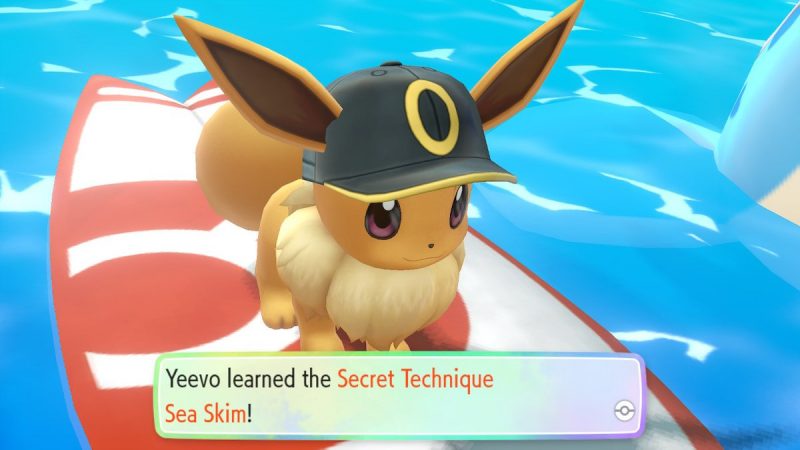 You start with a special non-evolving Eevee (or Pikachu in the alternate version), although not being able to evolve isn’t its only special quality. Previously, Eevee’s moveset didn’t have much variety, but it can now learn a number of exclusive attacks and special techniques, a necessary change if it wants to be in the same league as other starter Pokémon. The special techniques Eevee can learn are taught to Eevee as players progress and are used as a replacement for HMs. Although HMs no longer exist, the attacks that were once obtained through them still do, with plenty of Pokémon being able to learn them. Still having HM moves now without any of the drawbacks is a welcome change, particularly for those who still want Pokémon are their team to learn them for competitive purposes.
You start with a special non-evolving Eevee (or Pikachu in the alternate version), although not being able to evolve isn’t its only special quality. Previously, Eevee’s moveset didn’t have much variety, but it can now learn a number of exclusive attacks and special techniques, a necessary change if it wants to be in the same league as other starter Pokémon. The special techniques Eevee can learn are taught to Eevee as players progress and are used as a replacement for HMs. Although HMs no longer exist, the attacks that were once obtained through them still do, with plenty of Pokémon being able to learn them. Still having HM moves now without any of the drawbacks is a welcome change, particularly for those who still want Pokémon are their team to learn them for competitive purposes.

Another thing that makes this Eevee special is that it can wear different outfits and even match outfits with its trainer, such as hats, glasses, and shirts. The only problem with this is that the tuft of fur on its neck blocks most of the shirt and there isn’t that much variety in terms of hats. The variety for trainer outfits is lacking as well, as Pokémon Sun and Moon had a much better selection, as well as allowing players to actually take the hat off.
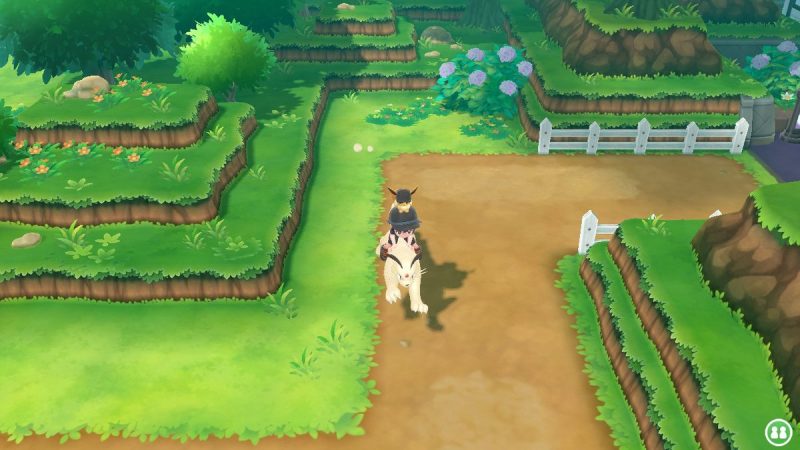
In addition to an always present Eevee and the return of following Pokémon, there are some who prefer that the player rides them, with a few select Pokémon being able to fly. A small annoyance with this system is that you’re unable to continue riding these Pokémon over caves or certain gates, which becomes much more apparent when searching for Pokémon to add to your collection.
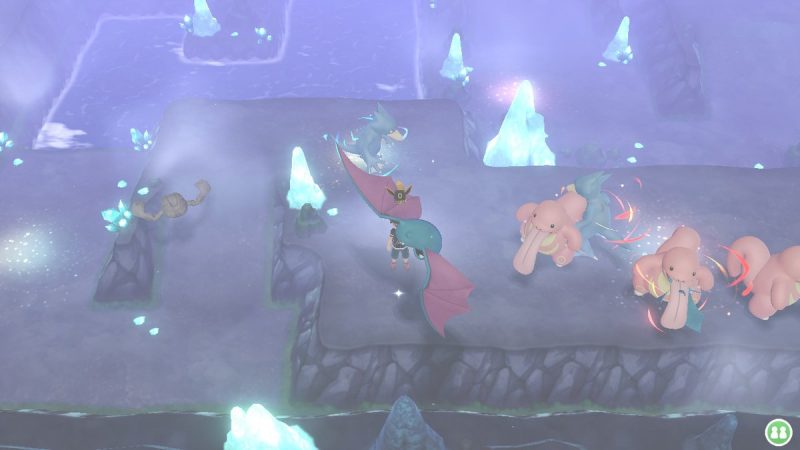
Random encounters are a thing of the past, with Pokémon now visibly moving in the overworld. This is a much-needed improvement which makes caves and water areas much easier to walk through, although due to some narrow paths and turns you may find yourself having unwanted encounters. It’s jarring at first, since Pokémon don’t only appear in tall grass, but will also walk on paths in the surrounding area, but you get used to it.
It’s not as visually impressive as some other Switch exclusive titles, but Let’s Go provides a much needed visual update. Since it reuses many assets from GO overall, it provides a vast improvement which I hope carries over to and is built upon more in the eighth generation games.
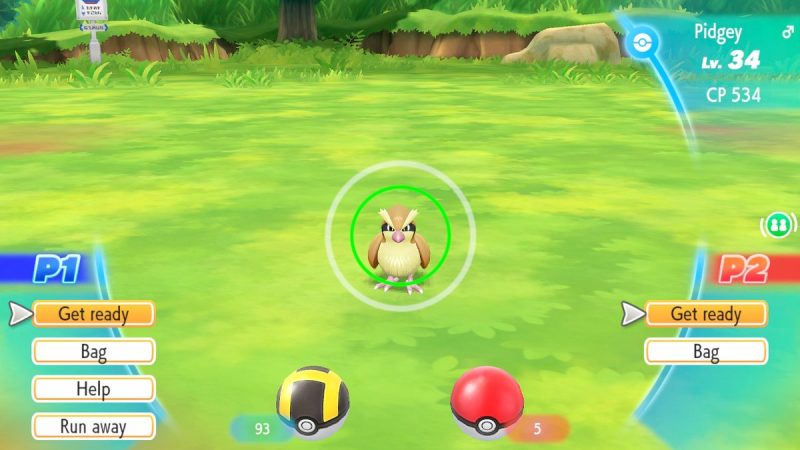
Let’s Go uses the catch mechanic introduced in Pokémon GO, and you’d be wrong to think this lacks challenge. You have to wait until the shrinking colored circle is the right size to throw one of your Pokéballs, with different colored circles representing a lower catch rate that can be made higher with better Pokéballs as well as Razz berries. The size of the circle isn’t the only timing factor, however, and you have to make sure to throw your Pokéball directly at the Pokémon while it’s not attacking. Some Pokémon also jump around a lot, making them harder to catch, but can be rectified with Nanab berries. Even with this new catch mechanic, a few select Pokémon must be defeated within a time-limit prior to being caught. In handheld mode, some gyro aiming is required for the jumpier Pokémon, but as long as you don’t mind tilting your switch around some this feature isn’t a huge deal.
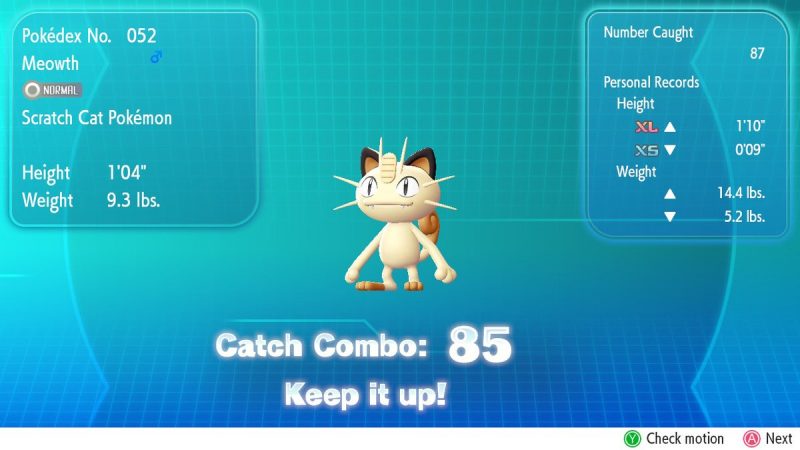
Catch combos are a new feature which rewards you for consecutively catching the exact same type of Pokémon, with higher combos increasing the chance of running into a Pokémon of that species with better stats or a shiny version of that Pokémon or other Pokémon in that area. Lures can be used to attract more Pokémon to appear and also help increase these chances even more. Between the new catch mechanic and combos, you would think that this means trainers run out of Pokéballs fast, but defeated trainers usually give you Pokéballs in addition to money, and Pokéballs can also often be found on the ground by either you or your following Pokémon. Higher catch combos also multiply the amount of experience your team gains, so it provides an easy way to level up, although some players may find this method to be too easy. Once you’ve caught enough of a specific Pokémon, you’ll gain a candy allowing you to raise every stat of said Pokémon by 1. Other candies you obtain this way can be given to any Pokémon and increase one of its stats by 1 as long as it’s in the correct level range. All of these changes help encourage the player to catch more of the same Pokémon, streamlining the process of trying to find the best one — even if it is more simplified than the breeding system used in past games.
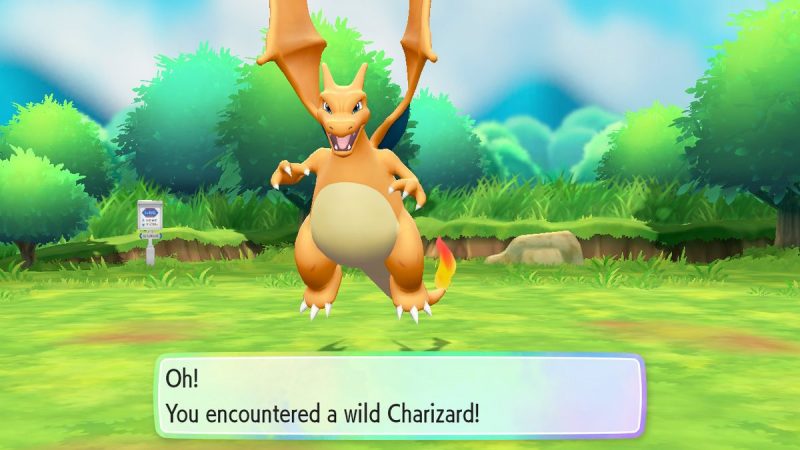
One other feature influenced by GO is that most Pokémon you couldn’t previously obtain in the wild are now rare encounters such as the three original starter Pokémon. Additionally, fully evolved Pokémon can be found and obtained throughout the region and even when flying in the sky. This is an excellent new feature which many have been waiting for since the first generation titles, and it’s great to see that wild encounters like this are finally possible after all this time. Additionally, the Alolan variant Pokémon introduced in Pokémon Sun and Moon are now unlimited in-game trades
The new Pokéball Plus controller provides a great alternative way and getting a pokéball ready to throw feels as if you’re pressing the button to expand it like in the anime. You can also choose to carry one of your Pokémon in the Pokéball Plus and it will gain experience when you walk or “play” with it by pressing the buttons and moving the controllers around, and you’ll even be rewarded with candies and heart scales when you transfer it back. Despite these enjoyable features, the controller does still have a few drawbacks. The analog stick which moves the player, as well as the arrow on menus, can be a tad too sensitive, causing the player to go the wrong direction or choose the wrong item for a split second. While it’s serviceable as a controller, it’s a bit cumbersome that you’d still need your left joy-con for the capture button.
Additionally, when players get to Fuschia City, they can access the GO Park to transfer their Pokémon from Pokémon GO, but can’t transfer them back. It’s a charming feature, but it doesn’t really add all that much to the overall experience.
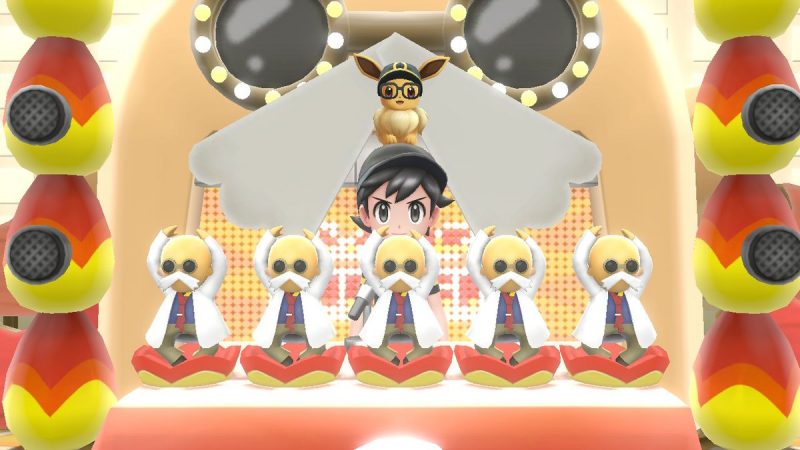
Being a reimagining of Pokémon Yellow, Gyms have returned with some new additional barriers for entry, such as type requirement, level requirement, and so on. This is an interesting feature, but feels unnecessary, and isn’t fun for those who just want to get to the next area. At times these additional requirements feel inconsistent, with the gym in Vermilion City having no change or additional requirement. My personal favorite variation, however, is when you take a quiz at the Cinnabar Island Gym, where you have to get each question correct and collect six Blaine dolls – while a Blaine clock is in the background – prior to challenging the Gym Leader himself.
A welcome change is the Pokémon Box, which replaces Bill’s PC from the original games. Gone are the days where you’d have to go to a Pokémon center to replace your team, for now, there’s a Pokémon Box which lets you swap your Pokémon in and out of your party whenever you’re outside of battle. This feature is great for leveling up and exploring caves, since you don’t have to travel all the way back to switch out your team, although it can make Gyms and the Elite Four much less of a challenge. The box is also where you can use the judge function to check each Pokémon’s stats and see how well they’re rated.
Also of note is that Pokémon do not have abilities and cannot use held items in Let’s Go, which can make battles easier in some respects but also removes much of the strategy that comes with stat enhancements and additional effects.

A big new feature in Let’s Go is the drop-in and drop-out co-op, where the second player assumes the role of the opposite sex of the first player and uses the same team; effectively turning battles into either double battles or two-on-one battles. The second player can also help with catching Pokémon, and when Pokéballs are thrown at the same time, the capture rate is increased and bonus experience is gained from synchronization if the Pokémon is caught. While this is enjoyable enough, it makes the rest of the main campaign much easier and maybe even unfair to trainers with only one Pokémon and Gym Leaders who now have to be fought two-on-one, so it’s best recommended for younger individuals who might be having trouble playing by themselves. Hopefully in the future, this drop in and drop out co-op can still exist alongside or even be intertwined with the two-player battle co-op from previous entries, with the added benefit of getting to explore together.
Although Let’s Go is mostly an updated version of how players remember the Generation 1 games, it still has something which many fans have been understandably complaining about for years: a lack of post-game content. A handful of strong and rare Pokémon are obtainable in the one post-game area featured, but there’s nowhere else to explore once finished.
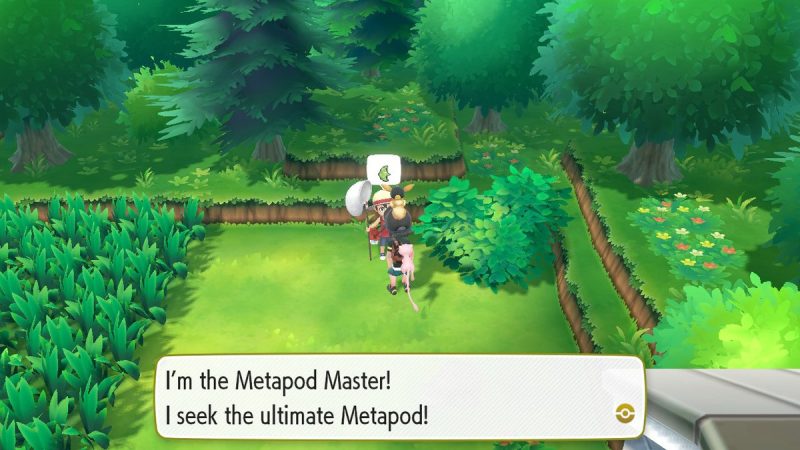
Master Trainers are also a new post-game feature, who span the entire region and are specialized in using the best version of one specific Pokémon. The twist is that when battling them, you have to use the same exact Pokémon as they do. This makes Master Trainers the most difficult part of the entire experience, and although the battles can seem boring at times, they can also get really tense and the reward of becoming a master trainer yourself and unlocking a few extras is worth it. After doing all of this all there’s left to do in the main campaign is completing your Pokédex and finding Shiny Pokémon.
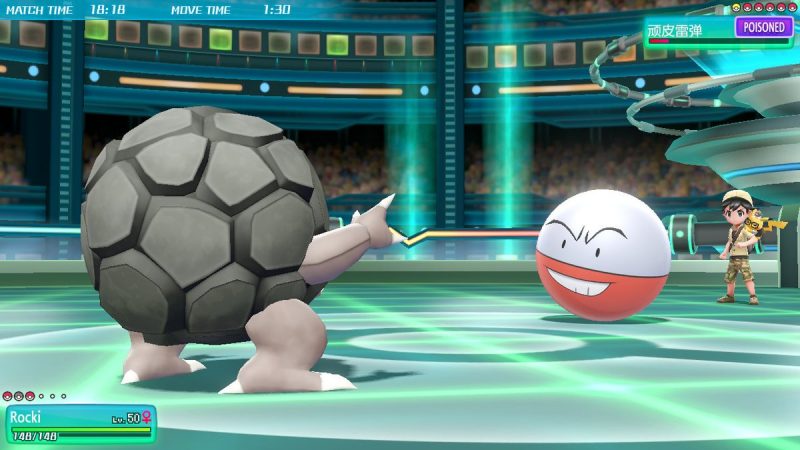
The online offering in Let’s Go is relatively lacking compared to its predecessors. You can trade or battle with friends and others…and that’s about it. Battling does offer you the option to turn on level advantages or not, which is nice for those seeking an equal playing field. It all feels rudimentary and like an unnecessary regression in design. The only saving grace here is the simplified password system, which is miles better than Nintendo’s tedious friend code system.



